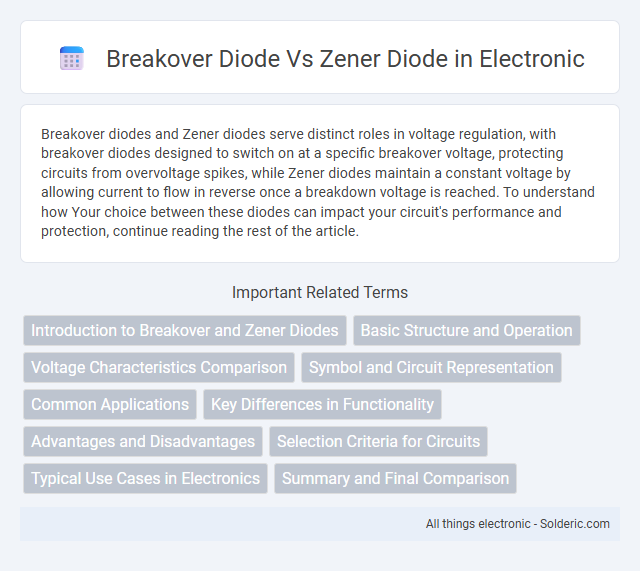Breakover diodes and Zener diodes serve distinct roles in voltage regulation, with breakover diodes designed to switch on at a specific breakover voltage, protecting circuits from overvoltage spikes, while Zener diodes maintain a constant voltage by allowing current to flow in reverse once a breakdown voltage is reached. To understand how Your choice between these diodes can impact your circuit's performance and protection, continue reading the rest of the article.
Comparison Table
| Feature | Breakover Diode | Zener Diode |
|---|---|---|
| Function | Conducts at a specific breakover voltage (switching action) | Regulates voltage by allowing current at a specific Zener voltage |
| Voltage Operation | Breakover voltage is higher than Zener voltage, triggers avalanche breakdown | Zener voltage is designed for precise voltage regulation |
| Application | Voltage-triggered switching, surge protection | Voltage regulation, voltage reference |
| Construction | PNPN structure, thyristor-like operation | PN junction diode with controlled breakdown characteristics |
| Current Conduction | Sharp transition from off to on state at breakover voltage | Maintains stable reverse current at Zener voltage |
| Common Usage | Triggering devices, voltage clamps | Voltage stabilizers, surge suppressors |
Introduction to Breakover and Zener Diodes
Breakover diodes, also known as avalanche diodes, are designed to conduct current once a specific breakover voltage is exceeded, making them ideal for overvoltage protection and switching applications. Zener diodes operate by maintaining a stable reverse voltage, the Zener voltage, allowing precise voltage regulation and reference in low-voltage circuits. Both diodes exploit controlled breakdown mechanisms but serve distinct roles: breakover diodes for surge handling and switching, and Zener diodes for voltage stabilization.
Basic Structure and Operation
Breakover diodes consist of a four-layer semiconductor structure (PNPN) and operate by switching from a high impedance state to a low impedance state when the applied voltage exceeds the breakover voltage, causing a sudden increase in current. Zener diodes have a simple PN junction designed to operate in the reverse breakdown region, maintaining a stable voltage by allowing current to flow in reverse once the Zener voltage is reached. The breakover diode is mainly used for voltage-triggered switching, while the Zener diode functions primarily as a voltage regulator or voltage reference.
Voltage Characteristics Comparison
Breakover diodes exhibit a sharp breakdown at a defined breakover voltage, allowing current to flow abruptly once this threshold is exceeded, typically used for triggering in circuits. Zener diodes operate in reverse bias with a precisely controlled Zener voltage, enabling stable voltage regulation by maintaining a constant voltage despite variations in current. The breakover diode's voltage characteristic shows a sudden drop after breakdown, while the Zener diode maintains a stable voltage plateau in its reverse bias region.
Symbol and Circuit Representation
Breakover diodes are symbolized similarly to standard diodes but include a breakover voltage indication, often depicted as a triangular arrow with a break line, highlighting their ability to conduct after a certain voltage threshold. Zener diodes use a standard diode symbol with bent edges on the bar, representing their ability to conduct in reverse bias at a precise breakdown voltage, essential for voltage regulation circuits. In your circuit designs, choosing between these diodes depends on whether you need controlled voltage clamping (Zener) or trigger-based conduction (Breakover).
Common Applications
Breakover diodes are commonly used in voltage surge protection and switching applications due to their ability to conduct current once a specific breakover voltage is reached. Zener diodes primarily serve as voltage regulators, providing stable reference voltages in power supplies and protecting circuits from voltage spikes. Understanding the distinct roles of these diodes can help you select the optimal component for controlling voltage and ensuring circuit stability.
Key Differences in Functionality
Breakover diodes function as triggered switches that conduct current after reaching a specific breakover voltage, enabling rapid transition from a high-resistance state to low resistance, typically used in surge protection and voltage regulation. Zener diodes maintain a stable reference voltage by allowing reverse current flow once the breakdown voltage is met, providing precise voltage regulation in circuits. Your choice between these components depends on whether you need a device for voltage clamping and switching (breakover diode) or for steady voltage regulation (Zener diode).
Advantages and Disadvantages
Breakover diodes offer rapid switching capabilities and high peak voltage tolerance, making them ideal for surge protection and triggering circuits. Their major disadvantage lies in their limited voltage regulation precision compared to Zener diodes. Zener diodes provide stable voltage regulation with low noise, essential for voltage reference and voltage regulation applications, but they tend to have slower response times and lower peak voltage handling compared to breakover diodes.
Selection Criteria for Circuits
Breakover diodes are ideal for circuits requiring a rapid switch from non-conducting to conducting state at a specific voltage, making them suitable for overvoltage protection and triggering applications. Zener diodes, on the other hand, excel in voltage regulation and reference roles due to their precise breakdown voltage and low noise characteristics. Your circuit selection depends on whether you need fast switch triggering or stable voltage regulation under varying loads and conditions.
Typical Use Cases in Electronics
Breakover diodes are primarily used in voltage-triggered switching applications, such as overvoltage protection and surge suppression circuits, where rapid conduction onset is essential. Zener diodes serve as voltage regulators, commonly implemented in voltage reference circuits, voltage clamping, and stabilization tasks to maintain a constant voltage level. Your choice between these diodes depends on whether you need a device for controlled switching (breakover diode) or precise voltage regulation (Zener diode).
Summary and Final Comparison
Breakover diodes are designed to conduct current once a specific breakover voltage is exceeded, primarily used for voltage triggering and protection in high-voltage circuits. Zener diodes maintain a stable reference voltage by operating in reverse breakdown at a precise Zener voltage, commonly used for voltage regulation and stabilization. While breakover diodes handle transient high-voltage spikes, Zener diodes provide continuous voltage control, making each suitable for distinct applications based on voltage control requirements.
Breakover diode vs Zener diode Infographic

 solderic.com
solderic.com